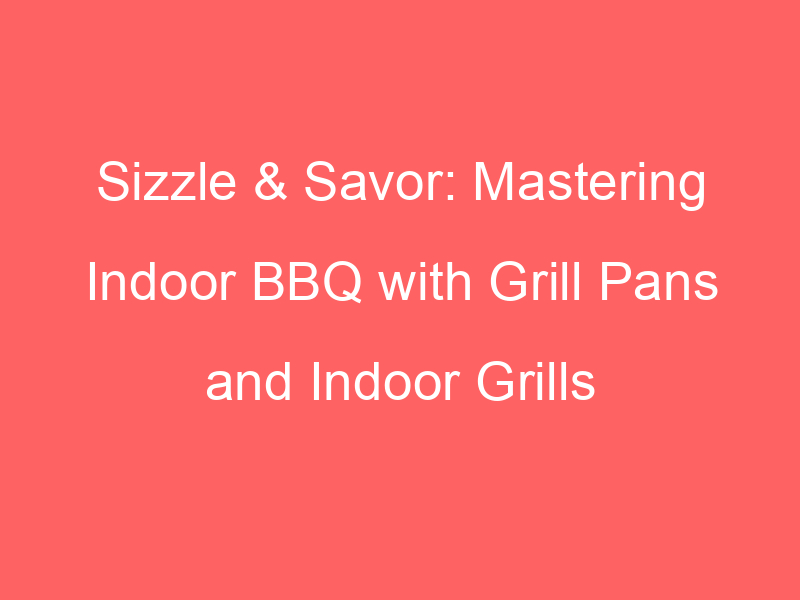
Introduction to Indoor BBQ
Indoor barbecuing is an exciting, flavorful, and convenient way to enjoy your favorite grilled foods, regardless of the weather outside. This guide will help you understand the concept of indoor BBQ, its benefits, and the challenges you might face.
- Understanding the concept of Indoor BBQ
- Benefits of Indoor BBQ
- Challenges of Indoor BBQ
Indoor BBQ is the process of grilling food indoors, typically using an indoor grill or stovetop grill pan. It’s a popular method for those who live in apartments or areas with inclement weather, as it allows you to enjoy grilled food all year round. Indoor BBQ can involve a variety of foods, from traditional BBQ favorites like burgers and hot dogs to vegetables, fish, and more.
Indoor BBQ offers several benefits. Firstly, it’s not weather-dependent, meaning you can grill your favorite foods regardless of rain, snow, or cold temperatures. Secondly, indoor grills are typically smaller and easier to clean than their outdoor counterparts. They’re also great for people living in apartments or condos where outdoor grilling may not be allowed. Lastly, indoor BBQ can be healthier, as many indoor grills are designed to drain off excess fat, reducing the calorie and fat content of your food.
While indoor BBQ has many benefits, it also comes with a few challenges. One of the main challenges is that it can be difficult to replicate the smoky flavor of outdoor grilling. Additionally, indoor grills may not get as hot as outdoor grills, which can affect the cooking time and final results of your food. Finally, indoor grilling can produce a lot of smoke, so proper ventilation is crucial.
In the following sections, we’ll delve deeper into the techniques, step-by-step guides, tips, and tricks for mastering the art of indoor BBQ. Whether you’re a seasoned griller or a beginner, this guide will help you make the most of your indoor grilling experience.
Indoor BBQ Techniques
Indoor barbecuing is a fantastic way to enjoy your favorite grilled foods, no matter the weather. One of the most effective methods of indoor BBQ involves the use of grill pans. Let’s delve into the details.
Using Grill Pans
Grill pans are a great alternative to outdoor grills. They can provide the same delicious BBQ flavor while being easy to use and clean. Here are some key points to consider when using grill pans for indoor BBQ.
- Choosing the Right Grill Pan
- Preheating the Grill Pan
- Grill Pans Tips for Perfect BBQ
- Don’t overcrowd the pan. This can lower the temperature and cause your food to steam instead of sear.
- Let your food come to room temperature before grilling. This helps it cook more evenly.
- Don’t move your food around too much. Let it sear undisturbed for a few minutes to get those perfect grill marks.
- Clean your grill pan after each use to prevent buildup and maintain its non-stick surface.
When it comes to grill pans, not all are created equal. The best grill pans have deep ridges, are made of cast iron for even heat distribution, and have a non-stick surface for easy cleaning. Size is also important. Choose a grill pan that fits your stove and has enough space for the amount of food you typically cook.
Preheating your grill pan is crucial for achieving that perfect sear and authentic BBQ flavor. It’s best to preheat your grill pan over medium heat for about 5 minutes before adding your food. This will ensure your food cooks evenly and gets those beautiful grill marks.
Here are some additional tips for achieving the perfect indoor BBQ with a grill pan:
Mastering indoor BBQ with a grill pan may take a bit of practice, but with these tips, you’ll be grilling like a pro in no time. Remember, the key to great BBQ is patience and attention to detail. Happy grilling!
Indoor Grills Usage
Indoor grilling is a fantastic way to enjoy the taste of BBQ all year round. But, to make the most of it, you need to understand the different types of grills, how to set them up, and the best grilling techniques. Let’s dive in!
- Understanding different types of Indoor Grills
- Setting up the Indoor Grill
- Indoor Grilling Techniques for juicy BBQ
There are two main types of indoor grills – open grills and contact grills. Open grills are similar to outdoor grills, with a single grilling surface. Food needs to be flipped for even cooking. Contact grills, on the other hand, have two grilling surfaces that cook food from both sides, reducing cooking time.
| Type of Grill | Description |
|---|---|
| Open Grill | Single grilling surface, food needs to be flipped for even cooking. |
| Contact Grill | Two grilling surfaces, cooks food from both sides, reducing cooking time. |
Setting up your indoor grill is easy. First, place it on a flat, stable surface away from any flammable items. Plug it in and preheat it for about 10 minutes. Some grills have temperature controls, so you can set it to the desired temperature for your food.
For a juicy BBQ, preheat your grill and avoid overcrowding it. Leave some space between pieces of food to allow for even heat distribution. Remember to flip food on an open grill for even cooking. For contact grills, there’s no need to flip. Most importantly, let your meat rest for a few minutes after grilling before cutting into it. This allows the juices to redistribute, resulting in a juicier BBQ.
Indoor grilling can be a fun and delicious experience. With the right grill, setup, and techniques, you can enjoy juicy BBQ any time of the year, right in the comfort of your own home!
BBQ Indoors: A Step-by-Step Guide
Indoor BBQ can be a delightful experience if done right. Let’s delve into the first step of the process: Preparation.
Preparation
Preparation is key to a successful indoor BBQ. It involves choosing the right meat, marinating it, and setting up your indoor BBQ station. Let’s break down these steps.
- Choosing the right meat
- Marinating techniques
- Setting up your indoor BBQ station
Selecting the right meat is crucial for a delicious BBQ. For beef, cuts like ribeye, sirloin, or T-bone are excellent choices. For chicken, go for bone-in, skin-on pieces. Pork ribs and shoulder are also great for BBQ. Always ensure the meat is fresh and of high quality.
Marinating enhances the flavor of the meat. A basic marinade includes an acid (like vinegar or lemon juice), oil, and seasonings. The acid tenderizes the meat, the oil adds moisture, and the seasonings provide flavor. Marinate the meat for at least 2 hours, or even better, overnight in the refrigerator.
Setting up your indoor BBQ station involves having the right tools and ensuring safety. You’ll need an indoor grill or grill pan, tongs, a meat thermometer, and oven mitts. Ensure your station is well-ventilated and keep a fire extinguisher nearby for safety.
With these steps, you’re well on your way to a successful indoor BBQ. Stay tuned for the cooking process in the next section.
Cooking
Now that we’ve prepared our indoor BBQ station and our meat is marinated and ready, it’s time to dive into the actual cooking process. This is where the magic happens! But remember, even the best chefs follow some basic steps to ensure their BBQ is cooked to perfection. Let’s explore these steps together.
- Controlling the Heat
- Flipping and Rotating
- Checking for Doneness
Controlling the heat is the first and most crucial step in the cooking process. It’s like the conductor of an orchestra, guiding all the other elements. If the heat is too high, your meat might burn on the outside while remaining raw on the inside. On the other hand, if the heat is too low, your meat might take too long to cook, losing its juicy tenderness. A good rule of thumb is to start with medium heat. If you see that your meat is cooking too fast, turn the heat down a bit. If it’s cooking too slowly, turn it up a notch.
Flipping and rotating your meat is the next step. This ensures that your meat cooks evenly on all sides. Remember, it’s not a pancake, so don’t flip it too often. A good practice is to flip your meat only once or twice during the entire cooking process. As for rotating, it’s a good idea to do it every few minutes, especially if your grill has hot spots.
The final step is checking for doneness. This is where you ensure that your meat is cooked just the way you like it. Some people prefer their meat rare, while others like it well-done. The best way to check for doneness is by using a meat thermometer. Insert it into the thickest part of the meat, away from the bone. If it reads 145°F (63°C) for steaks and roasts, and 165°F (74°C) for poultry, your meat is done. If you don’t have a meat thermometer, you can also check for doneness by cutting into the meat and checking the color. Remember, practice makes perfect, so don’t be discouraged if you don’t get it right the first time.
By following these steps, you’ll be well on your way to mastering the art of indoor BBQ. Remember, the key to a great BBQ is patience and practice. So, don’t rush the process, and most importantly, have fun!
Post-Cooking
-
Resting the meat
After you’ve finished cooking your meat, it’s important to let it rest. This means letting it sit for a few minutes before cutting into it. Why is this important? When you cook meat, the heat causes the juices to move towards the surface. If you cut into it right away, those juices will escape, leaving your meat dry. But if you let it rest, the juices will redistribute throughout the meat, making it more tender and flavorful. So next time you BBQ, remember to give your meat a little break before serving.
-
Serving suggestions
Now that your meat is perfectly cooked and rested, it’s time to serve it. But how should you serve it? Here are a few ideas:
- For a classic BBQ feel, serve your meat with traditional sides like coleslaw, baked beans, and cornbread.
- If you want to keep things light, pair your meat with a fresh salad or grilled vegetables.
- For a fun twist, try making BBQ tacos or sliders with your meat.
Remember, the best way to serve your BBQ is the way you and your guests like it best. So don’t be afraid to get creative!
-
Cleaning and maintaining your Grill Pans and Indoor Grills
After a successful BBQ, it’s time to clean up. Cleaning and maintaining your grill pans and indoor grills is crucial for their longevity and performance. Here’s how to do it:
- Let the grill cool down: Never try to clean a hot grill. It’s dangerous and could damage the grill.
- Scrape off any leftover food: Use a grill brush or scraper to remove any stuck-on food.
- Wash the grill: Use warm, soapy water and a sponge to clean the grill. Rinse thoroughly and dry.
- Oil the grill: Apply a small amount of cooking oil to a paper towel and lightly coat the grill. This helps prevent rust and keeps food from sticking next time you cook.
By following these steps, you’ll keep your grill in top shape and ready for your next BBQ.
Indoor Grilling Tips and Tricks
Indoor grilling can be a fun and delicious way to enjoy your favorite BBQ dishes. However, it can also be a bit tricky if you’re not familiar with some key techniques. Here are some tips and tricks to help you master the art of indoor grilling.
-
Using Foil to Prevent Sticking
One of the most common problems people face when grilling indoors is food sticking to the grill. This can be easily prevented by using aluminum foil. Simply place a sheet of foil on your grill before you start cooking. The foil creates a non-stick surface, making it easier to turn and remove your food. Plus, it makes cleanup a breeze!
-
Creating Grill Marks
Grill marks add a professional touch to your grilled dishes. They’re not just for show, they also add a distinct flavor to your food. To create perfect grill marks, preheat your grill on high. Place your food on the grill, then don’t move it until it’s time to turn. The high heat and lack of movement will create those beautiful grill marks. Remember, patience is key!
-
Managing Smoke
Indoor grilling can sometimes lead to a lot of smoke, which can set off your smoke alarm or make your kitchen smell. To manage this, always start with a clean grill. The buildup of grease and food particles can create more smoke. Also, use lean cuts of meat and trim any excess fat. If you’re still having trouble with smoke, consider investing in a smokeless indoor grill or an exhaust fan.
Indoor grilling doesn’t have to be difficult. With these tips and tricks, you can enjoy delicious, BBQ-style meals right in your own kitchen. So, don’t wait for the summer to have a BBQ, start grilling indoors today!
Case Studies: BBQ with Indoor Grills
Let’s delve into some real-life examples of indoor BBQ success. These case studies will provide you with practical insights and tips to help you master the art of indoor grilling.
-
Case Study 1: Achieving the Perfect Steak
John, a steak enthusiast, was initially skeptical about indoor grilling. However, he soon discovered that with the right technique, he could achieve a steak just as juicy and flavorful as one cooked on an outdoor grill. John’s secret? He preheats his grill to high heat, seasons his steak generously, and grills each side for 4-5 minutes for a medium-rare finish. The result is a steak with a beautiful sear on the outside and a tender, juicy inside.
-
Case Study 2: Grilling Vegetables Indoors
Susan, a vegetarian, loves to grill vegetables indoors. She found that grilling vegetables on an indoor grill gives them a unique, smoky flavor that she can’t get from roasting or sautéing. Susan’s favorite veggies to grill are bell peppers, zucchini, and eggplant. She slices them into thick pieces, brushes them with olive oil, and grills them for about 10 minutes. The result is perfectly grilled vegetables with a delightful char and a burst of flavor.
-
Case Study 3: Indoor BBQ for a Large Gathering
Mike and Lisa love to entertain. They decided to host a BBQ party for their friends, but the weather forecast predicted rain. Undeterred, they decided to use their indoor grill. They planned their menu carefully, choosing foods that could be prepared ahead of time and grilled quickly. They made burgers, hot dogs, and skewers of chicken and vegetables. The party was a hit, and their guests were impressed with the delicious, smoky flavor of the food. This case study shows that with a bit of planning, you can successfully host a large BBQ party indoors.
These case studies demonstrate that with the right techniques and a little practice, you can achieve excellent results with indoor BBQ. Whether you’re cooking for one or hosting a large gathering, an indoor grill can deliver the delicious, smoky flavor you crave.
Conclusion: Mastering the Art of Indoor BBQ
As we reach the end of our exploration into the world of indoor BBQ, it’s time to reflect on what we’ve learned and look forward to the delicious meals you’ll be creating in your own kitchen.
- Recap of Indoor BBQ Techniques
- Continued Practice and Experimentation
- Enjoying the Fruits of Your Labor
We’ve covered a range of techniques, from selecting the right indoor grill to understanding the importance of temperature control. We’ve also learned about different types of BBQ sauces and how to apply them for maximum flavor. Remember, the key to great indoor BBQ is patience and attention to detail.
Mastering the art of indoor BBQ isn’t something that happens overnight. It requires practice and a willingness to experiment. Don’t be afraid to try new recipes or techniques. Each time you cook, you’ll gain more experience and your skills will improve. Remember, even the most experienced chefs are always learning and trying new things.
Finally, the best part of indoor BBQ is getting to enjoy the fruits of your labor. Whether you’re cooking for yourself, your family, or a group of friends, there’s nothing quite like the satisfaction of serving up a delicious, home-cooked BBQ meal. So, take pride in your culinary creations and savor every bite.
Indoor BBQ is an art, but it’s an art that anyone can master with time and practice. So, keep grilling, keep experimenting, and most importantly, keep enjoying the delicious results. Here’s to your future as a master of indoor BBQ!






